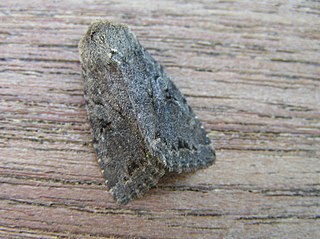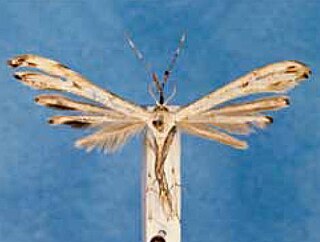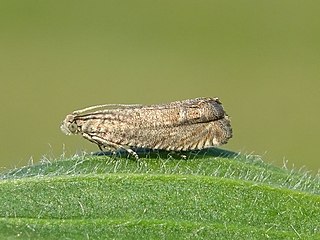
Apamea remissa, the dusky brocade, is a species of moth of the family Noctuidae. It is distributed throughout Europe and Turkey, ranging across the Palearctic realm to Siberia, Manchuria and Japan. It has also been reported from Alaska.

Agnippe is a genus of moths in the family Gelechiidae.

Fissipunctia ypsillon, the dingy shears, is a species of moth of the family Noctuidae. It is found in the Palearctic realm.

Hellinsia glochinias is a moth of the family Pterophoridae. It is found in Brazil and Costa Rica.
Rhopalosetia is a monotypic moth genus in the family Copromorphidae. Its only species, Rhopalosetia phlyctaenopa, is found in French Guiana. Both the genus and species were first described by Edward Meyrick in 1926.
Catacometes hemiscia is a moth in the family Oecophoridae. It was described by Edward Meyrick in 1883. It is found in Australia, where it has been recorded from New South Wales.
Hoplomorpha epicosma is a moth in the family Oecophoridae. It was described by Alfred Jefferis Turner in 1916. It is found in Australia, where it has been recorded from Queensland.
Garrha cholodella is a moth in the family Oecophoridae. It was described by Edward Meyrick in 1883. It is found in Australia, where it has been recorded from New South Wales.
Epermenia symmorias is a moth in the family Epermeniidae. It was described by Edward Meyrick in 1923. It is found in Fiji.
Dichomeris syringota is a moth in the family Gelechiidae. It was described by Edward Meyrick in 1926. It is found in Peru.
Hypatima ericta is a moth in the family Gelechiidae. It was described by Edward Meyrick in 1913. It is found in Sri Lanka.
Anarsia omoptila is a moth in the family Gelechiidae. It was described by Edward Meyrick in 1918. It is found in south India.
Agnippe aulonota is a moth in the family Gelechiidae. It is found in Ecuador.
Agnippe omphalopa is a moth in the family Gelechiidae. It is found in Ecuador, the Galapagos Islands and Guyana.
Agnippe abdita is a moth in the family Gelechiidae. It is found in North America, where it has been recorded from Utah, Arizona and California.
Agnippe fuscopulvella is a moth in the family Gelechiidae. It is found in North America, where it has been recorded from Kentucky.
Moca aphrodora is a species of moth in the family Immidae first described by Edward Meyrick in 1922. It is found in Brazil and Peru.

Cydia microgrammana is a moth belonging to the family Tortricidae. The species was first described by Achille Guenée in 1845.

Ancylis unguicella is a moth belonging to the family Tortricidae. The species was first described by Carl Linnaeus in his landmark 1758 10th edition of Systema Naturae.

Pammene ochsenheimeriana is a moth belonging to the family Tortricidae. The species was first described by Friederike Lienig and Philipp Christoph Zeller in 1846.






